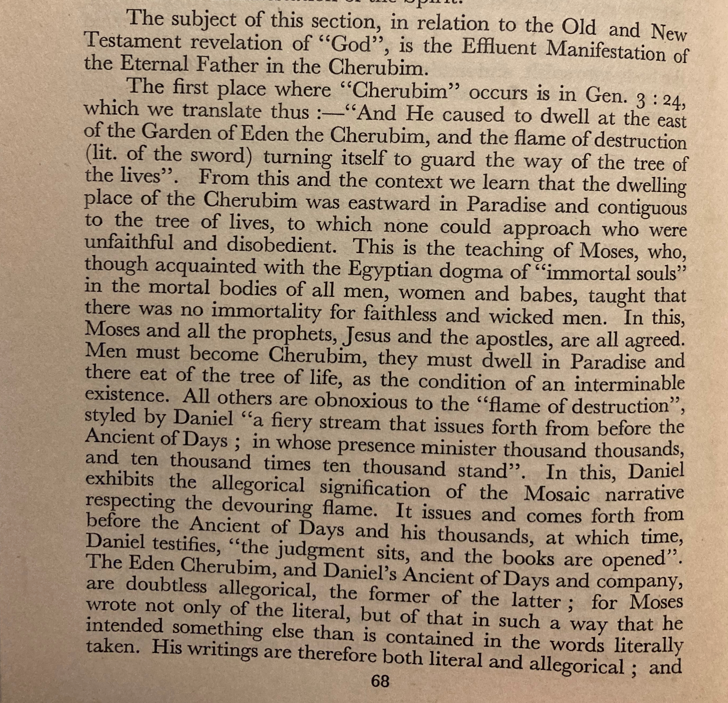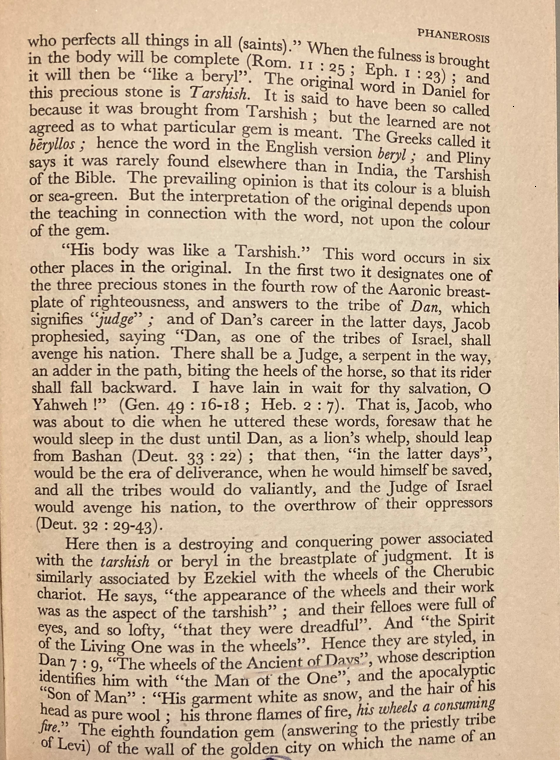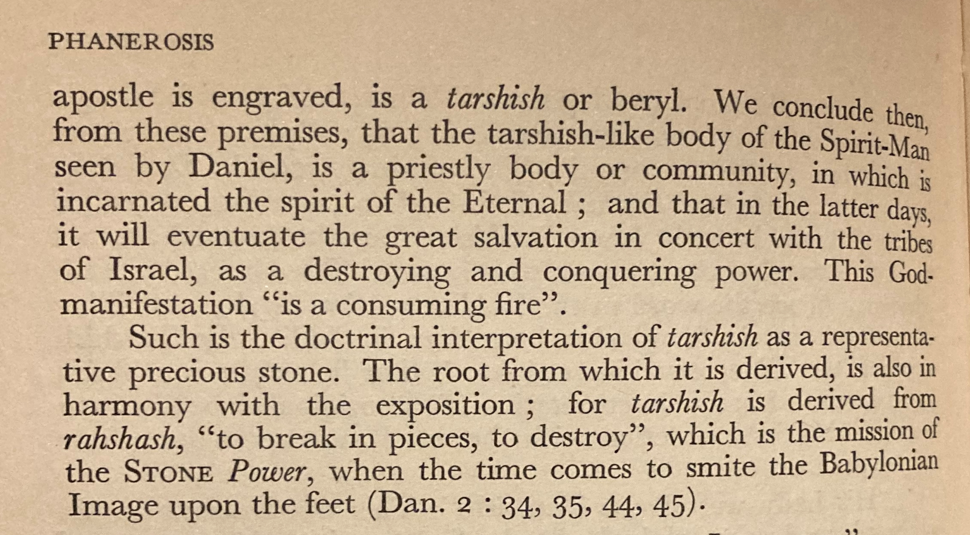John Thomas interprets the "Ancient of Days" to be both a corporate personality (the Church) and the "Son of Man" (Jesus) in light of his theology of theophany ("Phanerosis").
- Type
- Book
- Source
- John Thomas Non-LDS
- Hearsay
- DirectReprint
- Reference
John Thomas, Phanerosis: An Exposition of the Doctrine of the Old and New Testaments, Concerning the Manifestation of the Invisible Eternal God in Human Nature (Birmingham: The Christadelphian, 1954), 68-69, 82-84
- Scribe/Publisher
- The Christadelphian
- People
- John Thomas
- Audience
- Reading Public
- Transcription
The first place where “Cherubim” occurs is in Gen. 3:24, which we translate thus: — “And He caused to dwell at the east of the Garden of Eden the Cherubim, and the flame of destruction (lit. of the sword) turning itself to guard the way of the tree of the lives”. From this and the context we learn that the dwelling place of the Cherubim was eastward in Paradise and contiguous to the tree of lives, to which none could approach who were unfaithful and disobedient. This is the teaching of Moses, who, though acquainted with the Egyptian dogma of “immortal souls” in the mortal bodies of all men, women and babes, taught that there was no immortality for faithless and wicked men. In this, Moses and all the prophets, Jesus and the apostles, are all agreed. Men must become Cherubim, they must dwell in Paradise and there eat of the tree of life, as the condition of an interminable existence. All others are obnoxious to the “flame of destruction”, styled by Daniel “a fiery stream that issues forth from before the Ancient of Days; in whose presence minister thousand thousands, and then thousands times ten thousand stand”. In this, Daniel exhibits the allegorical signification of the Mosaic narrative respecting the devouring flame. It issues and comes forth from before the Ancient of Days and his thousands at which time, Daniel testifies, “the judgment sits, and the books are opened”. The Eden Cherubim, and Daniel’s Ancient of Days and company, are doubtless allegorical, the former of the latter; for Moses wrote not only of the literal, but of that in such a way that he intended something else than is contained in the words literally taken. His writings are therefore both literal and allegorical; and to understand them in their allegorical sense we must pay strict attention to their literal significance, which is “the form of the knowledge and the truth”. The literal narrative is “the form”; the “knowledge of the truth” and allegorical signification of that form.
Daniel’s Ancient of Days and the ten thousands that surround him in judgment are equivalent to “the holy messengers of the Lamb”, in Rev. 14:10, where we find fire and brimstone before them tormenting their enemies—the full allegorical development of the Eden Cherubic flame that guarded against all approach to the “tree of the lives” by the unfaithful and disobedient. “Whosoever was not found written in the Book of Life, was cast into the lake of fire and burning with brimstone.”
. . .
“HIS BODY WAS LIKE THE BERYL”
Daniel next informs us concerning the Spirit-man—“the Man of the One”—that “His body was like the beryl”. The “body” here is the “One Body” of which Paul speaks in his epistles; as “The Ecclesia which is his body, the fulness of him (the Spirit) who perfects all things in all (saints).” When the fulness is brought in the body will complete Rom. 11:25; Eph. 1:23); and it will then be “like a beryl”. The original word in Daniel for this precious stone is Tarshish. It is said to have been so called because it was brought from Tarshish; but the learned are not agreed as to what particular gem is meant. The Greeks called it bēryllos; hence the word in the English version beryl; and Pliny says it was rarely found elsewhere than in India, the Tarshish of the Bible. The prevailing opinion is that its colour is a bluish or sea-green. But the interpretation of the original depends upon the teaching in connection with the word, not upon the colour of the gem.
“His body was like a Tarshish.” This word occurs in six other places in the original. In the first two it designates one of three precious stones in the fourth row of the Aaronic breastplate of righteousness, and answers to the tribe of Dan, which signifies “judge”; and of Dan’s career in the latter days, Jacob prophesied, saying “Dan, as one of the tribes of Israel, shall avenge his nation. There shall be a Judge, a serpent in the way, an adder in the path, biting the heels of the horse, so that its rider shall fall backward. I have lain in wait for thy salvation, O Yahweh!” (Gen. 49:16-18; Heb. 2:7). That is, Jacob, who was about to die when he uttered these words, foresaw that he would sleep in the dust until Dan, as a lion’s whelp, should leap from Bashan (Deut. 33:22); that then, “in the latter days”; would be the era of deliverance, when he would himself be saved, and all the tribes would do valiantly, and the Judge of Israel would avenge his nation, to the overthrow of their oppressors (Deut. 32:29-43).
Here then is a destroying and conquering power associated with the tarshish or beryl in the breastplate of judgment. It is similarly associated by Ezekiel with the wheels of the Cherubic chariot. He says, “the appearance of the wheels and their work was at the aspect of the tarshish”; and their felloes were full of eyes, and so lofty, “that they were dreadful”. And “the Spirit of the Living One was in the wheels”. Hence they are styled, in Dan 7:9, “The wheels of the Ancient of Days”, whose description identifies him with “the Man of the One”, and the apocalyptic “Son of Man”; “His garment white as snow, and the hair of his head as pure wool; his throne flames of fire, his wheels a consuming fire.” The eighth foundation gem (answering to the priestly tribe of Levi) of the wall of the golden city on which the name of an apostle is engraved in a tarshish or beryl. We conclude then, from these premises, that the tarshish-like body of the Spirit-Man seen by Daniel, is a priestly body or community, in which is incarnated the spirit of the Eternal; and that in the latter days, it will eventuate the great salvation in concert with the tribes of Israel, as a destroying and conquering power. This God-manifestation “is a consuming fire”.
- Citations in Mormonr Qnas
The B. H. Roberts Foundation is not owned by, operated by, or affiliated with the Church of Jesus Christ of Latter-day Saints.





